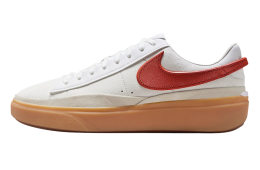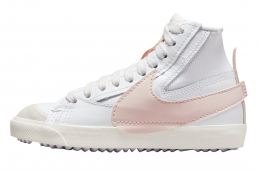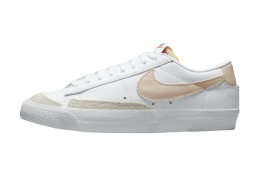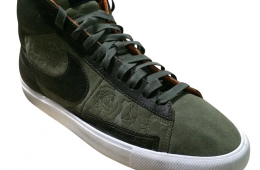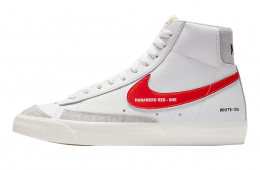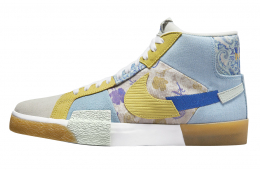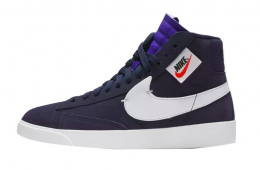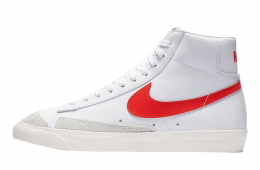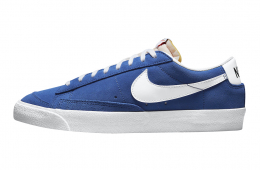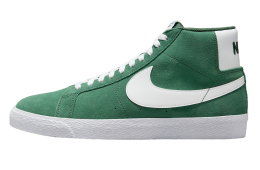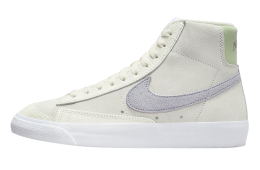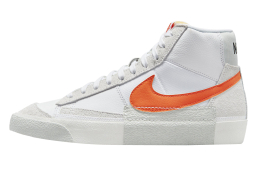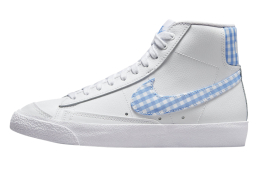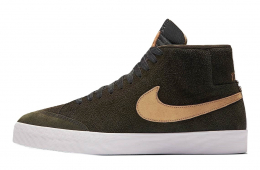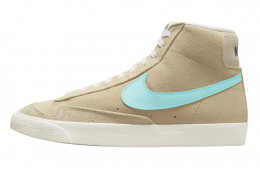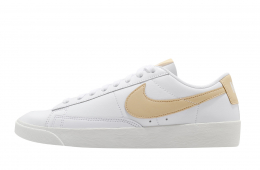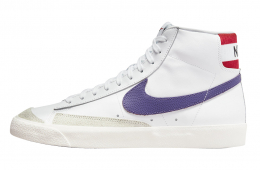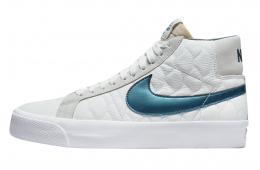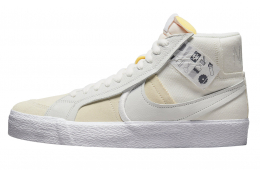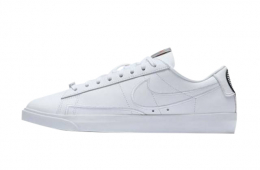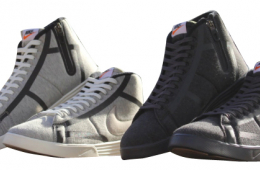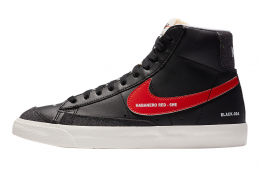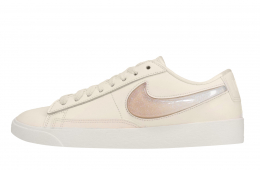Nike Blazer
The Nike Blazer, originally introduced in 1973, has transcended its roots as a pioneering basketball shoe to become an iconic symbol of streetwear and casual fashion. Named after the Portland Trail Blazers, the shoe was one of Nike's earliest basketball models, capturing the attention of the sporting world with its sleek design and innovative features. Built with a high-top silhouette, it provided ankle support for players and featured a durable leather upper that became a hallmark of its design. Over time, the shoe's versatility and clean lines have earned it a place in a variety of subcultures, from skaters in the '90s to today's fashion-conscious youth.
The modern-day Nike Blazer retains much of its vintage appeal, blending nostalgic elements with contemporary updates. Available in a wide array of colors and materials, it has grown beyond its athletic origins to become a staple in everyday wardrobes. Collaborations with artists, designers, and even luxury brands have elevated the Blazer to new heights, showcasing its adaptability and enduring appeal. Whether adorned with bold graphics or kept in classic white, the Nike Blazer continues to capture the imagination of style enthusiasts, solidifying its status as a timeless classic in the ever-evolving landscape of fashion.
read moreHistory of Nike Blazer
The history of the Nike Blazer is a fascinating journey that spans several decades, tracing the evolution of a simple basketball shoe into an iconic piece of athletic and streetwear culture. Introduced in the early 1970s, the Nike Blazer has been a versatile and constantly evolving sneaker that has permeated different aspects of sports, fashion, and popular culture. This comprehensive history aims to illuminate the key milestones in the development and impact of the Nike Blazer over the years.
The Birth of an Icon: 1973
The story begins in 1973 when Nike, then a relatively young company, was looking to make a mark in the competitive basketball shoe market. The brand had been founded just a few years earlier in 1964 by Bill Bowerman and Phil Knight under the name Blue Ribbon Sports. By 1971, the company had rebranded itself as Nike, named after the Greek goddess of victory, and was eager to create a high-performing basketball shoe.
Enter the Nike Blazer. Initially named after the local Portland Trail Blazers NBA team, this shoe marked one of Nike's first ventures into basketball footwear. The design was straightforward but effective: a high-top structure made from premium leather with a simple yet bold Nike Swoosh on the side. The initial design also included a rubber sole for better traction and support on the hardwood court.
The Blazer was instantly recognizable for its clean lines, durable construction, and eye-catching branding. At a time when basketball shoes were predominantly functional, the Nike Blazer stood out for merging performance with a strong aesthetic appeal. This was a crucial factor in its early success.
The Golden Era of Basketball: Late 1970s and Early 1980s
As the 1970s progressed and turned into the 1980s, basketball's popularity soared, and so did the reputation of the Nike Blazer. Several NBA players, including the legendary George "The Iceman" Gervin, wore the Blazer on the court. While it did not achieve the same level of iconic status as later models like the Air Jordan series, the Blazer was crucial in establishing Nike as a legitimate competitor in the world of basketball footwear.
The shoe featured various technical improvements during this period. The incorporation of a padded collar and improved cushioning provided better ankle support and comfort—factors that professional athletes highly valued. The rubber sole's herringbone pattern was designed to give superior traction, essential for the slick surfaces of basketball courts.
Transition to Streetwear: Mid to Late 1980s
As the 1980s progressed, the Nike Blazer began to transcend its roots as a basketball shoe. This period marked the shoe's transition from the hardwood courts to urban streets, where it became a staple in streetwear culture. The simplicity and versatility of the Blazer made it a favorite not only among basketball players but also among skaters, musicians, and fashion-forward individuals.
Skateboarding, in particular, embraced the Nike Blazer. Skaters found the shoe's durable construction and excellent traction perfect for their needs. The high-top design provided essential ankle support for the rigorous demands of skateboarding. The Blazer's leather upper was also durable enough to withstand the wear and tear of skate tricks. This crossover appeal marked the beginning of the Blazer's long-standing relationship with various subcultures.
Rebirth and Innovation: 1990s
While the Nike Blazer had successfully transitioned into the world of streetwear and skateboarding, the 1990s saw a relative decline in its prominence. Nike was focusing on pioneering new technologies such as Air Max cushioning and the Shox system, and the more straightforward design of the Blazer took a backseat.
However, this period was not without its moments of significance. The Blazer continued to be a reliable option for many, sustaining its classic status among sneaker enthusiasts. Moreover, it laid the groundwork for future revivals, priming itself for a resurgence in the upcoming decades.
The Revival: Early 2000s
The early 2000s marked a period of renaissance for the Nike Blazer. As retro and vintage fashion trends started to gain popularity, Nike capitalized on its rich history by re-releasing several classic models, including the Blazer. This reissue of the Blazer not only tapped into nostalgia but also introduced the shoe to a new generation of sneaker aficionados.
In 2005, Nike's innovative SB (Skateboarding) division brought the Blazer back to the forefront with the release of the Nike SB Blazer. Featuring enhanced cushioning, a Zoom Air insole, and other skate-specific modifications, the SB Blazer aimed to cater directly to the skateboarding community. Collaborations with iconic skateboarding pros like Lance Mountain ensured the shoe's success within this subculture.
Collaborations and Limited Editions: Mid to Late 2000s
The mid to late 2000s saw the Nike Blazer become a canvas for collaborations and limited-edition releases. High-profile partnerships with designers, artists, and other brands brought fresh, creative spins to the classic silhouette, keeping it ever-relevant in the fast-paced world of fashion and sneaker culture.
One notable collaboration was with streetwear brand Supreme in 2006. The Supreme x Nike SB Blazer featured premium materials, distinctive colorways, and unique design elements that turned it into an instant classic. These collaborations were not just about aesthetics; they often included performance upgrades, thereby broadening the shoe’s appeal across various audiences.
The 2010s: Solidifying Legacy
The 2010s were a decade of solidifying the Blazer’s legacy. Multiple collaborations continued to push the envelope of design and performance. Off-White, under the direction of Virgil Abloh, created one of the most sought-after versions of the Nike Blazer in 2017. Part of "The Ten" collection, the Off-White Blazer featured deconstructed elements, zip ties, and bold text, encapsulating the high-fashion-meets-streetwear ethos that defined much of sneaker culture during this period.
Simultaneously, the general release versions of the Blazer continued to sell well. Its classic, clean design remained a go-to choice for those looking for versatile and stylish footwear. Nike also introduced various technological updates to ensure the shoe kept pace with contemporary standards of comfort and performance.
The Present and Future
As of the early 2020s, the Nike Blazer remains as iconic and relevant as ever. In a market saturated with new designs and cutting-edge technologies, the Blazer’s blend of simplicity and heritage continues to stand out. Modern iterations often pay homage to the original design while incorporating updated materials and features, catering to both nostalgic fans and new consumers.
Nike has shown that even nearly 50 years after its introduction, the Blazer has not lost its appeal. The shoe’s ability to adapt and reinvent itself makes it a true icon in the world of sneakers.
Cultural Impact
The Nike Blazer's influence extends beyond just being a popular sneaker. It has played a significant role in various cultural movements and has been featured in numerous artistic and social contexts. From being prominently displayed in music videos and movies to appearing on the feet of fashion icons and athletes, the Blazer has become a symbol of style, versatility, and enduring appeal.
Conclusion
The history of the Nike Blazer is a compelling narrative of innovation, adaptation, and timeless appeal. From its origins as a high-performance basketball shoe in the 1970s to its current status as a streetwear icon, the Blazer has continually evolved to stay relevant. It has seamlessly transitioned through different phases of cultural significance, be it in sports, skateboarding, or fashion. As we look to the future, the Nike Blazer will undoubtedly continue to be a staple in the ever-changing landscape of sneaker culture.
